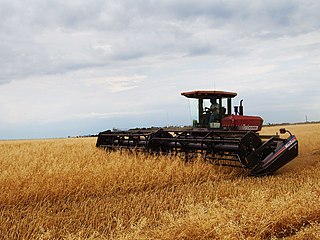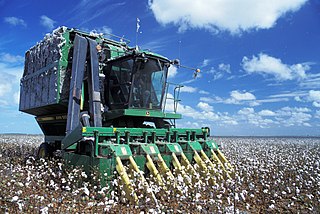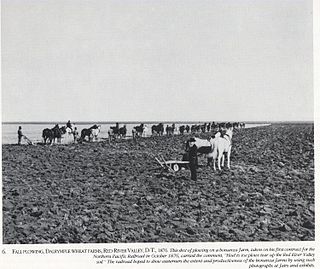In agriculture, custom harvesting or custom combining is the business of harvesting of crops for others. Custom harvesters usually own their own combines and work for the same farms every harvest season. Custom harvesting relieves farmers from having to invest capital in expensive equipment while at the same time maximizing the machinery's use. [1]

Agriculture is the science and art of cultivating plants and livestock. Agriculture was the key development in the rise of sedentary human civilization, whereby farming of domesticated species created food surpluses that enabled people to live in cities. The history of agriculture began thousands of years ago. After gathering wild grains beginning at least 105,000 years ago, nascent farmers began to plant them around 11,500 years ago. Pigs, sheep and cattle were domesticated over 10,000 years ago. Plants were independently cultivated in at least 11 regions of the world. Industrial agriculture based on large-scale monoculture in the twentieth century came to dominate agricultural output, though about 2 billion people still depended on subsistence agriculture into the twenty-first century.

Harvesting is the process of gathering a ripe crop from the fields. Reaping is the cutting of grain or pulse for harvest, typically using a scythe, sickle, or reaper. On smaller farms with minimal mechanization, harvesting is the most labor-intensive activity of the growing season. On large mechanized farms, harvesting utilizes the most expensive and sophisticated farm machinery, such as the combine harvester. Process automation has increased the efficiency of both the seeding and harvesting process. Specialized harvesting equipment utilizing conveyor belts to mimic gentle gripping and mass transport replaces the manual task of removing each seedling by hand. The term "harvesting" in general usage may include immediate postharvest handling, including cleaning, sorting, packing, and cooling.
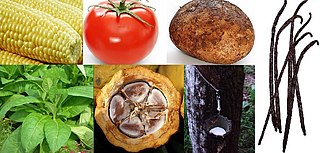
A crop is a plant or animal product that can be grown and harvested extensively for profit or subsistence. Crop may refer either to the harvested parts or to the harvest in a more refined state. Most crops are cultivated in agriculture or aquaculture. A crop is usually expanded to include macroscopic fungus, or alga (algaculture).
The custom harvesting industry has its roots in the mid-twentieth century. Before the invention of the combine harvester, farmers usually owned their own harvesting machinery and worked in tandem with migrant workers, who would bring their own threshing equipment. As combines became more and more widespread, the demand for migrant labor decreased. Custom harvesters, owning their own combines, existed beginning in the 1920s, albeit on a small scale. [2] However, World War II caused a labor and materials shortage, and the custom harvesting industry experienced a great growth. In North America, the area from Texas to Saskatchewan was heavily traversed by custom harvesters. In 1942, there were approximately 500 such operators in this range, but by 1947 that number had grown to 8,000 in Kansas alone. Over the years, the industry transformed from one being run solely by men into family-run businesses. Harvesters would pass their routes and clients down to their children, thus turning custom combining into family tradition. [1]

A farmer is a person engaged in agriculture, raising living organisms for food or raw materials. The term usually applies to people who do some combination of raising field crops, orchards, vineyards, poultry, or other livestock. A farmer might own the farmed land or might work as a laborer on land owned by others, but in advanced economies, a farmer is usually a farm owner, while employees of the farm are known as farm workers, or farmhands. However, in the not so distant past, a farmer was a person who promotes or improves the growth of by labor and attention, land or crops or raises animals.

A "migrant worker" is a person who either migrates within their home country or outside it to pursue work such as seasonal work. Migrant workers usually do not have an intention to stay permanently in the country or region in which they work.

Threshing is the process of loosening the edible part of grain from the husks and straw to which it is attached. It is the step in grain preparation after reaping and before winnowing, which separates the grain from the chaff. Threshing does not remove the bran from the grain.
Custom combiners charge for their services in several ways: a flat per-unit of land price, a per-bale price, or a percentage of the crop. One of the biggest problems for farmers who hire custom harvesters is the availability of labor and the timing of the harvest. If the harvester cannot be available right when the crops are ready, there is the risk of low harvest (if too early) or spoilage (if too late). [3]
The number of custom harvesters has dropped in modern times due to a number of reasons. For one, the consolidation of farms into large-scale operations has allowed them to operate on economies of scale such that they do not need to rely on contractors. Competition is another reason. In China, custom harvesting became such a popular profession in the late 20th century that too many people entered the industry and prices became too low to generate a profit. [4]
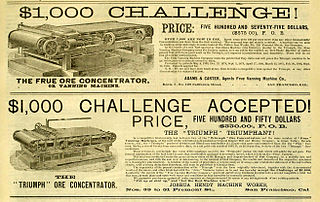
In economics, competition is a condition where different economic firms seek to obtain a share of a limited good by varying the elements of the marketing mix: price, product, promotion and place. In classical economic thought, competition causes commercial firms to develop new products, services and technologies, which would give consumers greater selection and better products. The greater selection typically causes lower prices for the products, compared to what the price would be if there was no competition (monopoly) or little competition (oligopoly).







